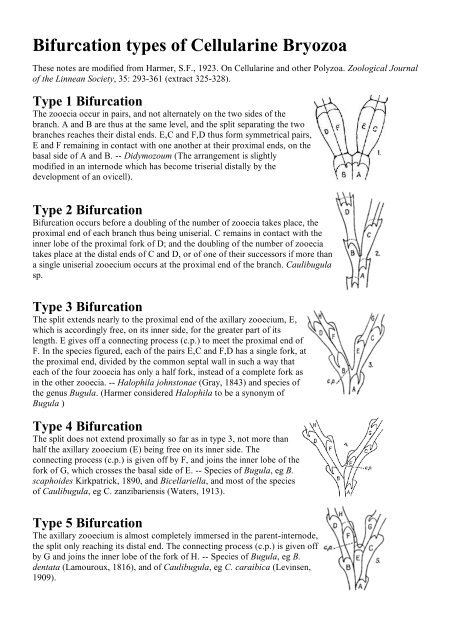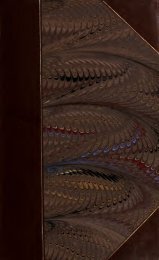Bryozoan Bifurcation Types - The Bryozoa Home Page
Bryozoan Bifurcation Types - The Bryozoa Home Page
Bryozoan Bifurcation Types - The Bryozoa Home Page
Create successful ePaper yourself
Turn your PDF publications into a flip-book with our unique Google optimized e-Paper software.
<strong>Bifurcation</strong> types of Cellularine <strong>Bryozoa</strong><strong>The</strong>se notes are modified from Harmer, S.F., 1923. On Cellularine and other Polyzoa. Zoological Journalof the Linnean Society, 35: 293-361 (extract 325-328).Type 1 <strong>Bifurcation</strong><strong>The</strong> zooecia occur in pairs, and not alternately on the two sides of thebranch. A and B are thus at the same level, and the split separating the twobranches reaches their distal ends. E,C and F,D thus form symmetrical pairs,E and F remaining in contact with one another at their proximal ends, on thebasal side of A and B. -- Didymozoum (<strong>The</strong> arrangement is slightlymodified in an internode which has become triserial distally by thedevelopment of an ovicell).Type 2 <strong>Bifurcation</strong><strong>Bifurcation</strong> occurs before a doubling of the number of zooecia takes place, theproximal end of each branch thus being uniserial. C remains in contact with theinner lobe of the proximal fork of D; and the doubling of the number of zooeciatakes place at the distal ends of C and D, or of one of their successors if more thana single uniserial zooecium occurs at the proximal end of the branch. Caulibugulasp.Type 3 <strong>Bifurcation</strong><strong>The</strong> split extends nearly to the proximal end of the axillary zooecium, E,which is accordingly free, on its inner side, for the greater part of itslength. E gives off a connecting process (c.p.) to meet the proximal end ofF. In the species figured, each of the pairs E,C and F,D has a single fork, atthe proximal end, divided by the common septal wall in such a way thateach of the four zooecia has only a half fork, instead of a complete fork asin the other zooecia. -- Halophila johnstonae (Gray, 1843) and species ofthe genus Bugula. (Harmer considered Halophila to be a synonym ofBugula )Type 4 <strong>Bifurcation</strong><strong>The</strong> split does not extend proximally so far as in type 3, not more thanhalf the axillary zooecium (E) being free on its inner side. <strong>The</strong>connecting process (c.p.) is given off by F, and joins the inner lobe of thefork of G, which crosses the basal side of E. -- Species of Bugula, eg B.scaphoides Kirkpatrick, 1890, and Bicellariella, and most of the speciesof Caulibugula, eg C. zanzibariensis (Waters, 1913).Type 5 <strong>Bifurcation</strong><strong>The</strong> axillary zooecium is almost completely immersed in the parent-internode,the split only reaching its distal end. <strong>The</strong> connecting process (c.p.) is given offby G and joins the inner lobe of the fork of H. -- Species of Bugula, eg B.dentata (Lamouroux, 1816), and of Caulibugula, eg C. caraibica (Levinsen,1909).
Type 6 <strong>Bifurcation</strong>Although F is in contact with B, it appears to be derived from E, which itmeets near the middle of the latter. <strong>The</strong> connection between the proximalends of the inner zooecia of the branches is formed by the independentjunction of F and G with E. <strong>The</strong> proximal ends of the zooecia are notbifurcate. Oblique joints, indicated by dotted lines and of a type commonin Bugula, traverse the zooecia. Euoplozoum cirratum Busk, 1884, p.17.Type 7 <strong>Bifurcation</strong>Resembles type 6 in the relation of G and F to E, but is peculiar in otherrespects. <strong>The</strong> axillary zooecium (E), which gives rise to F and G, passes intothe proximal end of the branch on the side opposite to A, a relation whichhas not been found in any other type. B takes no part in the doubling of thenumber of zooecia, the proximal ends of which are not bifurcate -Kinetoskias cyathus and all the other species (4) examined.Type 8 <strong>Bifurcation</strong><strong>The</strong> proximal segments of F and G are in contact on the basal side of E,and are shorter than the corresponding parts of C and D; the jointstraversing F and G near their proximal ends, and passing much moredistally through C and D. In the species figured (Scrupocellaria ferox,Busk, 1852) the joint traverses the middle of the opesia, which isrepresented by dotted lines, of each of the outer zooecia C and D. Incertain other species of the genus each joint passes across the proximalend of the opesia of the outer zooecium; and in others, particularlythose with elongated zooecia, it passes entirely on the proximal side ofthe opesia of C and D. - Scrupocellaria, all species. Himantozoum maybe considered to belong to this type, with which it agrees except that itis unjointed.Type 9 <strong>Bifurcation</strong><strong>The</strong> proximal segments of F and G are not in contact, and are shorter thanthe corresponding parts of C and D; the joints traversing CG and DFrespectively. A rootlet-chamber occurs on the proximal segment of C or D,or of both, and the rootlet is thus given off on the proximal side of of thejoint - Tricellaria spp.Type 10 <strong>Bifurcation</strong><strong>The</strong> proximal segments of F and G are separated by the whole width ofE, and the two branches come off at different levels, that on the side ofA being more proximally situated. Internodes commonly composed ofthree zooecia, C and D then taking on the character of A and B zooeciain the next internode. - Tricellaria spp. (figured specimen, T. dentalisvar. dilatata Ortmann, 1889, p.21)
Type 11 <strong>Bifurcation</strong>Except in the fact that the proximal segments of F and G are in contact, thisagrees with type 9. - Tricellaria peachii (Busk)Type 12 <strong>Bifurcation</strong>Readily derivable from type 10 by the suppression of the proximalsegments of F and G, the internode thus consisting of a single zooeciumat its proximal end, connecting with its predecessor by a singlechitinous joint. - Tricellaria aculeata d'Orbigny.Type 13 <strong>Bifurcation</strong>A modification agreeing with type 12, occurring in Emma cyathus. <strong>The</strong>zoecia C and D take on the character of A and B zooecia at their distal ends.Type 14 <strong>Bifurcation</strong>Internodes composed of three zooecia and, like the zooecia, very short. Aslight modification of type 9. - Emma spp.Type 15 <strong>Bifurcation</strong>Proximal segments of F and G in contact, much longer than thecorresponding parts of J and K. <strong>The</strong> joints are on the distal sides of C and D,and traverse the zooecia FJ and GK. <strong>The</strong> joints are situated at some distancefrom the axil, instead of being on the same level with it, and do not traversethe opesia of any zooecium. Rootlets given off on the distal sides of thejoints. - Notoplites. A modification represented, in the same genus, in the"Siboga" collection, results from the suppression of one of the joints of thebifurcation.
Type 16 <strong>Bifurcation</strong><strong>The</strong> axillary zooecium is free on both sides distally. <strong>The</strong> zooecia Fand G are not in contact with one another, but each is connectedwith one side of E at a point marked by the presence of aconspicuous rosette-plate (r.p.) - Cornucopina, all speciesexamined. <strong>The</strong> zooecia are very long, and a constriction partiallyseparates a small proximal section from the main part of thezooecium.Type 17 <strong>Bifurcation</strong>Proximal segments of F and G in contact (rarely separated), longer than thecorresponding parts of J and K. <strong>The</strong> joints are on the distal sides of C and D,lying hardly in advance of the axil, and they traverse the zooecia FJ and GK,passing through the opesia of F and G, the two inner zooecia. Rootlets givenoff on the distal sides of the joints. - Menipea.Type 18 <strong>Bifurcation</strong><strong>The</strong> internode becomes triserial by the development of a median row of two ormore zooecia. <strong>The</strong> distal member of the median row (E 2 in the figuredspecimen) behaves as an axillary zooecium. <strong>Bifurcation</strong> in other respects as intype 17. - Menipea (triserial species).Type 19 <strong>Bifurcation</strong>Part of a sympodial colony of Menipea spicata, only one of the branches beingjoined at each bifurcation.Type 20 <strong>Bifurcation</strong>Agreeing with type 8 except for the intercalation of a median series of zooecia inthe internode. Amastigia kirkpatricki (Lev., MSS). n.sp.
















